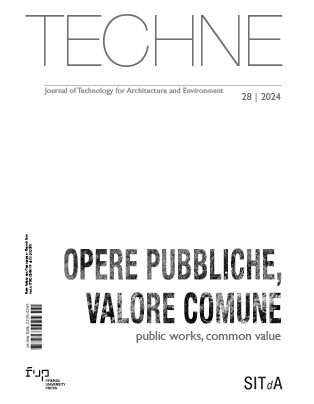Published 2024-10-29
Keywords
- Environmental design,
- Public works,
- Urban identity
How to Cite
Copyright (c) 2024 Elena Mussinelli

This work is licensed under a Creative Commons Attribution 4.0 International License.
Abstract
What are public works, and under what conditions can they be considered a “common value” recognized by the community? The contributions to issue n. 28 of TECHNE Journal delve into these conditions, offering critical reflections and research advancements that examine cities, buildings, places, and public services from the perspective that «the entire urban space must be regarded as something produced, owned, and transformed collectively» (Marella, 2024). There are three main areas of reflection and proposal: the first involves the methods and procedural and design tools that can be employed for the recovery and adaptive reuse of public works facing functional obsolescence, abandonment, and/or decay; the second addresses the regenerative processes of public spaces and entire urban sectors with a focus on usability and environmental sustainability; and the third concerns the participatory design of public works as a vital lever for the creation of social value. This set of design actions is well-supported by analytical and evaluative tools that guide the decision-making process, all driven by an interest in optimizing the socio-economic, cultural, and environmental benefits that can result from more effective and efficient public works production and management processes, especially in response to evolving social demands.
Downloads
References
- Hoekstra, R. (2019), Replacing GDP by 2030: Towards a Common Language for the Well-Being and Sustainability Community, Cambridge University Press. DOI: https://doi.org/10.1017/9781108608558
- Unhabitat (2022), Progress in the Implementation of the New Urban Agenda (2019-2022). Quadrennial report of the Secretary-General. Available at: https://unhabitat.org/sites/default/files/2022/02/sq_quadrennial_report_advance_02_2022.pdf.
- Mussinelli, E., Schiaffonati, F. and Torricelli, M.C. (2022), “For a necessary change”, TECHNE – Journal of Technology for Architecture and Environment, Vol. 23, pp. 15-20. Available at: https://doi.org/10.36253/techne-12915. DOI: https://doi.org/10.36253/techne-12915
- Bemporad, S. and Codello, R. (Eds) (2022), Imprese private e pubbliche virtù: Progetti e visioni in dialogo sul bene comune, Marsilio Editori.
- Agrawal, S. and Sharma, N. (2023), “Beyond GDP: A Movement Toward Happiness Economy to Achieve Sustainability”, in Oncel, S.S. (Eds), A Sustainable Green Future, Springer, Cham. Available at: https://doi.org/10.1007/978-3-031-24942-6_5. DOI: https://doi.org/10.1007/978-3-031-24942-6_5
- Mazzucato, M. (2024), “Governing the economics of the common good: from correcting market failures to shaping collective goals”, Journal of Economic Policy Reform, Vol. 27, n. 1, pp. 1-24. Available at: https://doi.org/10.1080/17487870.2023.2280969. DOI: https://doi.org/10.1080/17487870.2023.2280969
- Foà, S. (2024), “Gli antipodi da conciliare: i brownfields e i beni comuni urbani”, Quaderni di «filosofia – filosofia urbana 2024, Mimesis Edizioni. Available at: https://www.mimesisedizioni.it/libro/9791222308067.
- Mussinelli, E. (2024), “Project quality, regulation quality”, TECHNE – Journal of Technology for Architecture and Environment, Vol. 27, pp. 10-14. Available at: https://doi.org/10.36253/techne-16054. DOI: https://doi.org/10.36253/techne-16054
- Agenzia del Demanio (2024), Partenariato pubblico-privato. Il caso dell’immobile pubblico.
- Marella, R.M. (2024), “Lo spazio urbano come bene comune”, TECHNE – Journal of Technology for Architecture and Environment, Vol. 28, pp. 28-34. DOI: https://doi.org/10.36253/techne-16555






